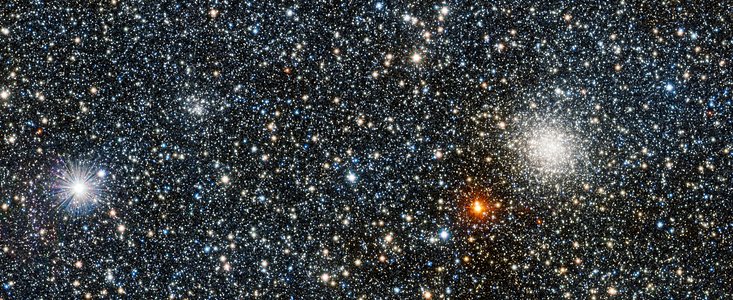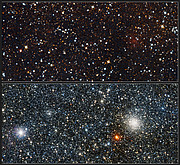Press Release
VISTA Finds New Globular Star Clusters
and sees right through the heart of the Milky Way
19 October 2011
Two newly discovered globular clusters have been added to the total of just 158 known globular clusters in our Milky Way. They were found in new images from ESO’s VISTA survey telescope as part of the Via Lactea (VVV) survey. This survey has also turned up the first star cluster that is far beyond the centre of the Milky Way and whose light has had to travel right through the dust and gas in the heart of our galaxy to get to us.
The dazzling globular cluster called UKS 1 dominates the right-hand side of the first of the new infrared images from ESO’s VISTA survey telescope at the Paranal Observatory in Chile. But if you can drag your gaze away, there is a surprise lurking in this very rich star field — a fainter globular cluster that was discovered in the data from one of VISTA’s surveys. You will have to look closely to see the other star cluster, which is called VVV CL001: it is a small collection of stars in the left half of the image.
But VVV CL001 is just the first of VISTA’s globular discoveries. The same team has found a second object, dubbed VVV CL002, which appears in image b [1]. This small and faint grouping may also be the globular cluster that is the closest known to the centre of the Milky Way. The discovery of a new globular cluster in our Milky Way is very rare. The last one was discovered in 2010, and only 158 globular clusters were known in our galaxy before the new discoveries.
These new clusters are early discoveries from the VISTA Variables in the Via Lactea (VVV) survey that is systematically studying the central parts of the Milky Way in infrared light. The VVV team is led by Dante Minniti (Pontificia Universidad Católica de Chile) and Philip Lucas (Centre for Astrophysics Research, University of Hertfordshire, UK).
As well as globular clusters, VISTA is finding many open, or galactic clusters, which generally contain fewer, younger, stars than globular clusters and are far more common (eso1128). Another newly announced cluster, VVV CL003, seems to be an open cluster that lies in the direction of the heart of the Milky Way, but much further away, about 15 000 light-years beyond the centre. This is the first such cluster to be discovered on the far side of the Milky Way.
Given the faintness of the newly found clusters, it is no wonder that they have remained hidden for so long; up until a few years ago, UKS 1 (seen in image a), which easily outshines the newcomers, was actually the dimmest known globular cluster in the Milky Way. Because of the absorption and reddening of starlight by interstellar dust, these objects can only be seen in infrared light and VISTA, the world’s largest survey telescope, is ideally suited to searching for new clusters hidden behind dust in the central parts of the Milky Way [2].
One intriguing possibility is that VVV CL001 is gravitationally bound to UKS 1 — making these two stellar groups the Milky Way’s first binary globular cluster pair. But this could just be a line-of-sight effect with the clusters actually separated by a vast distance.
These VISTA pictures were created from images taken though near-infrared filters J (shown in blue), H (shown in green), and Ks (shown in red). The size of the images show only a small fraction of the full VISTA field of view.
Notes
[1] The discovery of the additional new clusters was just announced in San Juan, Argentina, during the first bi-national meeting of the Argentinian and Chilean astronomical associations.
VVV CL001 was also noted independently on near-infrared images taken by amateur astronomer Steve Crouch of Canberra, Australia using a 31.75-cm telescope along with a CCD camera. Steve's image is available here: http://members.pcug.org.au/~stevec/uks1_STL6303_RC_IR_LRGB.jpg.
[2] The tiny dust grains that form huge clouds within galaxies scatter blue light much more strongly than red and infrared light. As a result astronomers can see through the dust much more effectively if they study infrared light rather than the usual visible radiation that our eyes are sensitive to.
More information
ESO, the European Southern Observatory, is the foremost intergovernmental astronomy organisation in Europe and the world’s most productive astronomical observatory. It is supported by 15 countries: Austria, Belgium, Brazil, Czechia, Denmark, France, Finland, Germany, Italy, the Netherlands, Portugal, Spain, Sweden, Switzerland and the United Kingdom. ESO carries out an ambitious programme focused on the design, construction and operation of powerful ground-based observing facilities enabling astronomers to make important scientific discoveries. ESO also plays a leading role in promoting and organising cooperation in astronomical research. ESO operates three unique world-class observing sites in Chile: La Silla, Paranal and Chajnantor. At Paranal, ESO operates the Very Large Telescope, the world’s most advanced visible-light astronomical observatory and two survey telescopes. VISTA works in the infrared and is the world’s largest survey telescope and the VLT Survey Telescope is the largest telescope designed to exclusively survey the skies in visible light. ESO is the European partner of a revolutionary astronomical telescope ALMA, the largest astronomical project in existence. ESO is currently planning a 40-metre-class European Extremely Large optical/near-infrared Telescope, the E-ELT, which will become “the world’s biggest eye on the sky”.
Links
- Associated research papers: A&A papers (Minniti et al A&A, 527, 81 & Moni Bidin et al. astro-ph:1109.1854)
- Photos of VISTA
Contacts
Dante Minniti
Pontificia Universidad Católica de Chile
Santiago, Chile
Tel: +56 2 463 3267
Email: dante@astro.puc.cl
Maren Hempel
Pontificia Universidad Católica de Chile
Santiago, Chile
Tel: +56 2 354 4945
Email: mhempel@astro.puc.cl
Christian Moni Bidin
Universidad de Concepción
Concepción, Chile
Tel: +56 9 9210 3235
Email: cmbidin@astro-udec.cl
Richard Hook
ESO, La Silla, Paranal, E-ELT and Survey Telescopes Public Information Officer
Garching bei München, Germany
Tel: +49 89 3200 6655
Cell: +49 151 1537 3591
Email: rhook@eso.org
About the Release
| Release No.: | eso1141 |
| Name: | VVV CL001, VVV CL002, VVV CL003, VVV Survey |
| Type: | Milky Way : Star : Grouping : Cluster : Globular |
| Facility: | Visible and Infrared Survey Telescope for Astronomy |
| Instruments: | VIRCAM |
| Science data: | 2011A&A...535A..33M 2011A&A...527A..81M |








